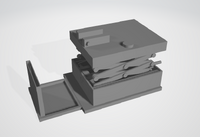BME100 f2018:Group12 T1030 L6
| Home People Lab Write-Up 1 | Lab Write-Up 2 | Lab Write-Up 3 Lab Write-Up 4 | Lab Write-Up 5 | Lab Write-Up 6 Course Logistics For Instructors Photos Wiki Editing Help | ||||||
OUR COMPANY
Above STANDard Fluorimeter LAB 6 WRITE-UPBayesian StatisticsOverview of the Original Diagnosis System Throughout the course of the PCR lab, there were 17 teams and each has approximately four to five students. There was a total of 34 patients and three tests were run for each. The results were analyzed and each group came up with either a positive or negative conclusion/diagnosis for each patient. To prevent error, three tests were run for each patient. Running multiple tests prevents errors because it provides data for comparison. It also helps get a more accurate result after averaging the three results. Also, if there is an error in one trial, then there are two other tests to base results off of. Another precaution that was taken to prevent error was there were positive and negative controls. The positive and negative controls give baseline data to compare the results with. This is useful in detecting any errors in the experiment. Overall, the results were mixed. There were a few inconclusive results. In addition, there were some incongruences where the conclusion would be positive, but the disease was not detected. What Bayes Statistics Imply about This Diagnostic Approach The result of calculation 1 being close to 1 mean that the individual PCR replicates are very reliable for concluding when a person has the disease SNP. The result of calculation 2 also bing very close to 1 means that the individual PCR replicates are very good at telling when the individual has the healthy SNP. The two calculations combined being both very close to 1 makes it very reasonable to conclude that the individual PCR replicates are very reliable at determining whether or not the individual has the disease SNP.
One possible source of both human and machine error that could have occured during the PCR steps could have occured during the micropipetting. It is possible that the whole 50mL did not make it to the test tubes as air could have been sucked up instead of liquid. Another possible source of error would be if we left the SYBR Green 1 out in the light for too long causing it to start being photobleached before we finished all our trials. This would decrease the fluorescence of the droplets. A third possible source of error could be that we didn’t line up the laser with the droplet completely correctly for some of the trials. This would cause the SYBR Green 1 to not be activated and the drops would not glow no matter what the SNP there was. Intro to Computer-Aided Design3D Modeling
Our Design
Our design changed some aspects of the fluorimeter to try to lessen the amount of error when using it. The new design includes a camera stand that is linked to the fluorimeter so that the distance between the two will remain consistent throughout experiments. The new design also makes the height of the fluorimeter adjustable so that random objects will not be needed to match the height if the camera. Finally the last change to the old design was to change the light switch into a button so that activating it will not make the fluorimeter shift and move.
Feature 1: ConsumablesThe kit would need to come bundled with necessary reagents like the PCR mix, SYBR Green, and buffer, as well as the glass slides that fit the fluorimeter and plastic tubes that fit the PCR machine. These consumables listed are essential to using the product and are made to specifically fit our design. Other objects like the micropipette and micropipette tips are essential to the machines use, but are not specifically made to be used for the PCR machine so any micropipette and tips would be fine for use with the machine. Feature 2: Hardware - PCR Machine & FluorimeterOur design changed some aspects of the fluorimeter to try to lessen the amount of error when using it. Some sources error include the distance between the camera and droplet possibly changing, the objects have to be stacked to get the height which could lead to objects falling, and the black box sometimes allows light in which can possibly photobleach the samples. In addition, when turning on the switch the distance between the camera and droplet can also be changed. The new design includes a camera stand that is linked to the fluorimeter so that the distance between the two will remain consistent throughout experiments. The new design also makes the height of the fluorimeter adjustable so that random objects will not be needed to match the height of the camera. Finally, the last change to the old design was to change the light switch into a button so that activating it will not make the fluorimeter shift and move.
| ||||||





